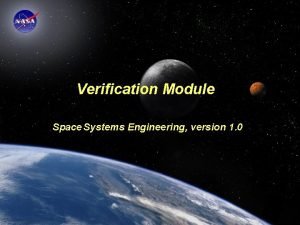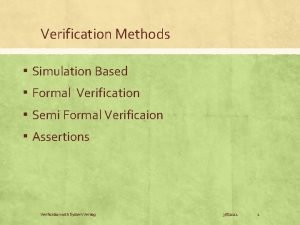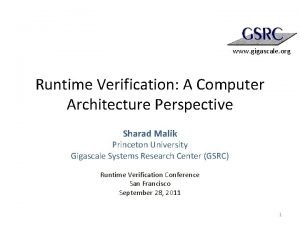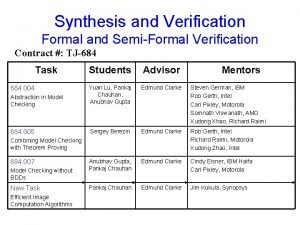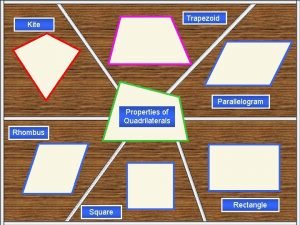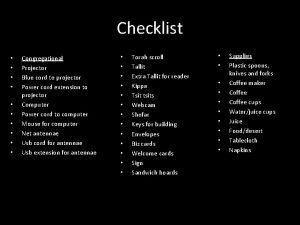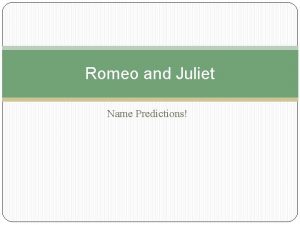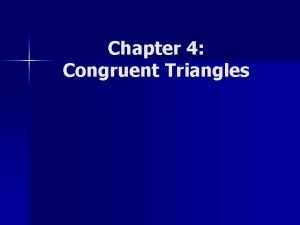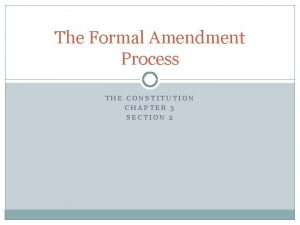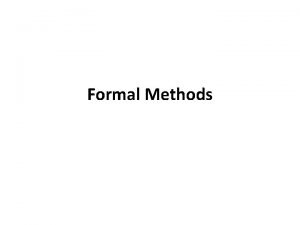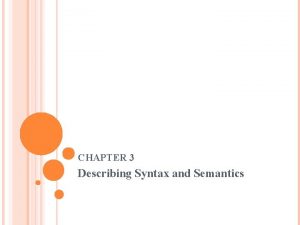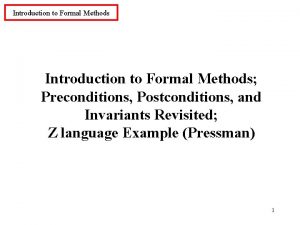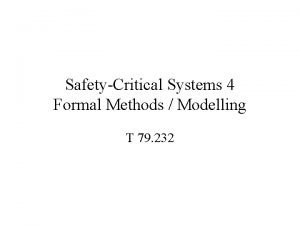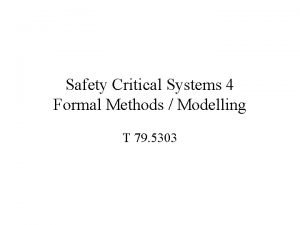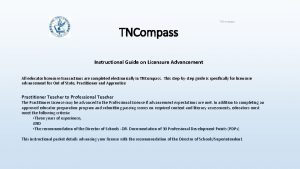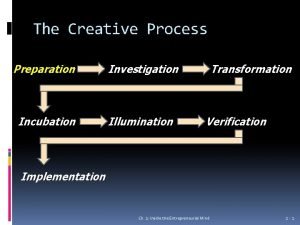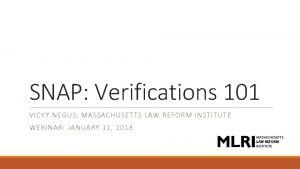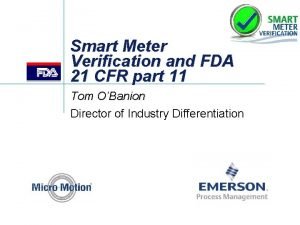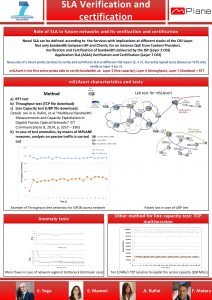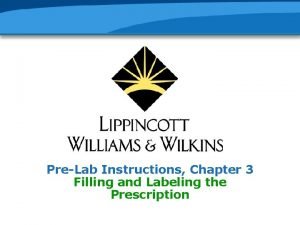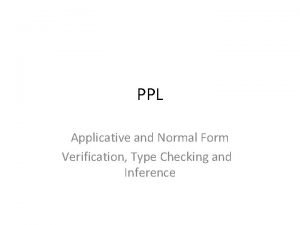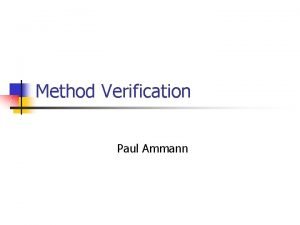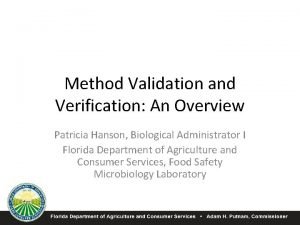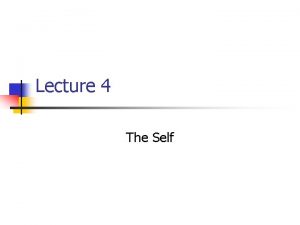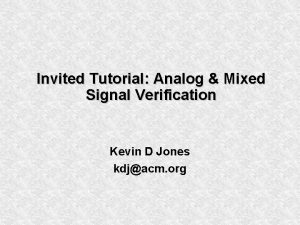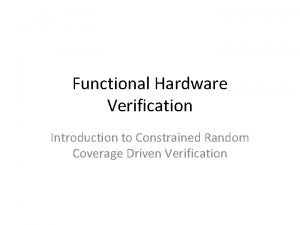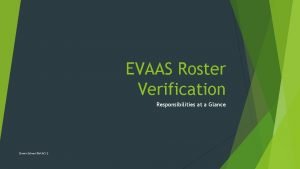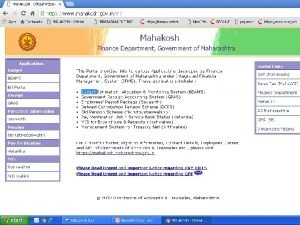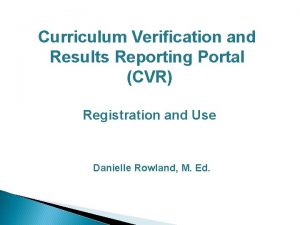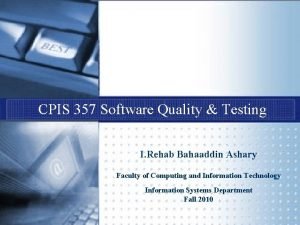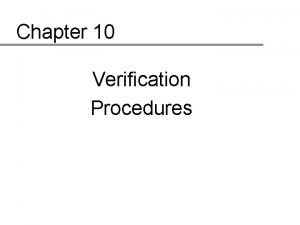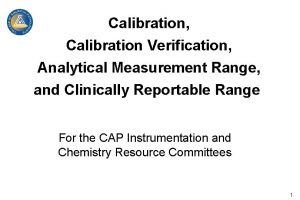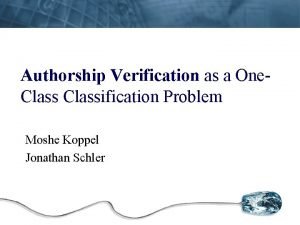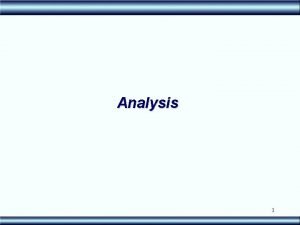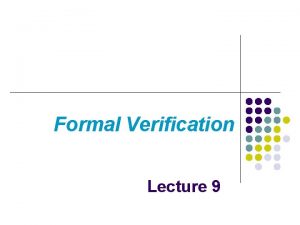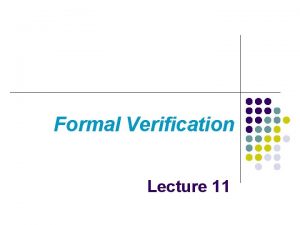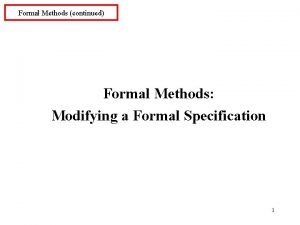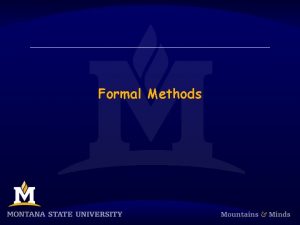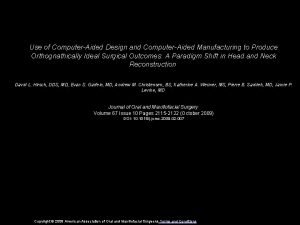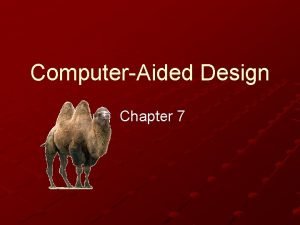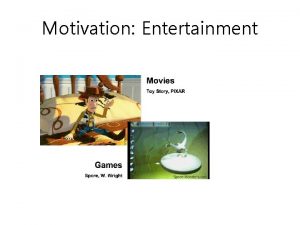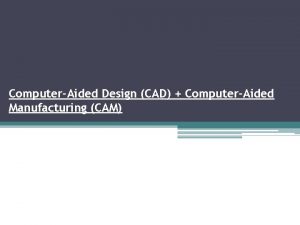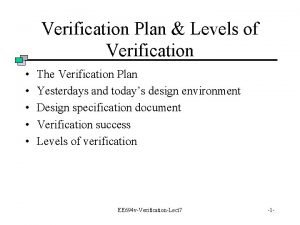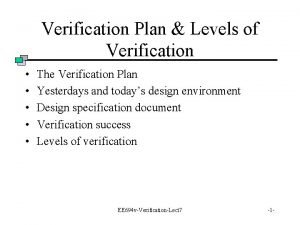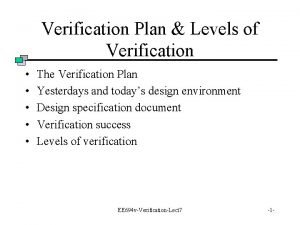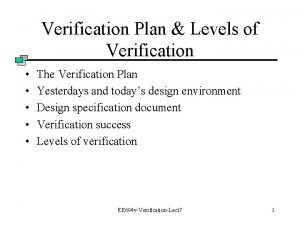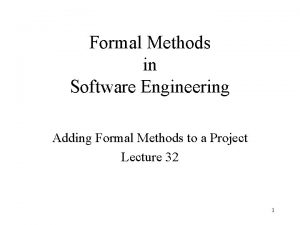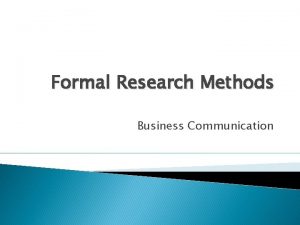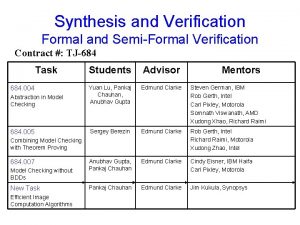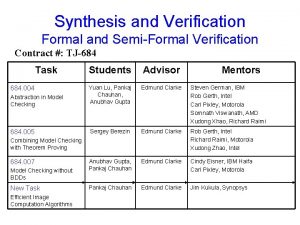ComputerAided Verification 1 Other names Formal methods Formal



























































- Slides: 59

電腦輔助驗證 Computer-Aided Verification 1

Other names Formal methods Formal verification Automated verification

Class Web Page zwww. ee. ntu. edu. tw/~yen/courses/cav 02 z. E-mail: yen@ee. ntu. edu. tw z. Phone: 2363 5251 ext. 540 z. Office Hours: By appointment

Useful book z. Model Checking, E. Clarke, O. Grumberg, D. Peled, MIT Press

Topics Introduction Automata Theory Temporal Logics: LTL, CTL* Model Checking w-Automata, m-calculus BDD and Symbolic Model Checking Timed and Hybrid Automata, Notion of Equivalence, Region Technique, Approximation z Other Infinite-State Systems (Petri Nets, Parameterized Systems, Broadcast Protocols, CFSM …) and analytical techniques z Case Study z z z z

Framework Applications visual. STATE PVS Logic • Temporal Logic • Modal Logic • MSOL • • UPPAAL SPIN HOL Algorithmic TLP • (Timed) Automata Theory • Graph Theory • BDDs • Polyhedra Manipulation • • ALF Semantics • Concurrency Theory • Abstract Interpretation • Compositionality • Models for real-time & hybrid systems • •

What? Validation and Verification of software and hardware DESIGNS! (E. g. , real time systems, embedded systems, communication protocols)

A REAL real time system Klaus Havelund, NASA

Embedded Systems Sync. Master 17 GLsi Mobile Phone Telephone Digital Watch Tamagotchi

Why? z. Testing/simulation of designs/implementations may not reveal error (e. g. , no errors revealed after 2 days) z. Formal verification (=exhaustive testing) of design provides 100% coverage (e. g. , error revealed within 5 min). z. TOOL support.

W VI E Problem Area RE The Waterfall Model S Traditional Software Development Analysis VI Testing Ru Sy nni st ng em ¨ Costly in time-to-market and money ¨ Errors are detected late or never ¨ Application of FM’s as early as possible RE Implementation EW S Design

Introducing, detecting and repairing errors

Formal Verification & Validation Analysis S D HO AL FO RM ET Design Model M UM Validation L Specification Verification & Refusal Implementation Testing

Formal Verification & Validation Analysis S D HO AL FO RM ET Design Model M UM Validation L Specification Verification & Refusal : LS AL TE O TO UPPA l. STA ua s i v N I SP Implementation Testing

Formal Verification & Validation Analysis S D HO AL FO RM ET Design Model M UM Validation L Specification Verification & Refusal Automatic Code generation : LS AL TE O TO UPPA l. STA ua s i v. …. Implementation Testing

Formal Verification & Validation Analysis S D HO AL FO RM ET Design Model M UM Validation L Specification Verification & Refusal Automatic Code generation Automatic Test generation : LS AL TE O TO UPPA l. STA ua s i v. …. Implementation Testing

How? Unified Model = State Machine! b? a Input ports y! x b? b x! Control states a? y Output ports

UPPAAL

SPIN, Gerald Holzmann AT&T

visual. STATE VVS w Baan Visualstate, DTU (CIT project) z Hierarchical state systems z Flat state systems z Multiple and interrelated state machines z Supports UML notation z Device driver access

Train Simulator 1421 machines 11102 transitions 2981 inputs 2667 outputs 3204 local states Declare state sp. : 10^476 VVS visual. STATE BUGS ? n o i t a e c i f i er nitud v d ag e c u ed s of m ) r as rder sec h es ral o to 6 q iu ve n ys h a e c d s r te with x 14 u O e (e m ti

‘State Explosion’ problem M 1 b a 1 c M 2 2 3 4 M 1 x M 2 1, a 4, a 1, b 2, b 1, c 2, c 3, a 4, a 3, b 4, b 3, c 4, c l All combinations = exponential in no. of tica e r heo le t b ly components rovab tracta P in

Tool Support System Description A No! Debugging Information TOOL Requirement F Course Objectives: • Model systems and specify requirements • Understand main underlying theoretical and practical problems • Validate models using TOOLS Yes, Prototypes Executable Code Test sequences Tools: UPPAAL, SPIN, Visual. STATE, Statemate, Verilog, Formalcheck, . . .

Model Checking G(p -> F q) yes MC no p q z output y yes y no + counterexample z input: y temporal logic spec y finite-state model

Linear temporal logic (LTL) z. A logical notation that allows to: yspecify relations in time yconveniently express finite control properties z. Temporal operators y. G p y. F p y. X p yp U q “henceforth p” “eventually p” “p at the next time” “p until q”

Types of temporal properties z Safety (nothing bad happens) G ~(ack 1 & ack 2) “mutual exclusion” G (req -> (req W ack)) “req must hold until ack” z Liveness (something good happens) G (req -> F ack) “if req, eventually ack” z Fairness GF req -> GF ack req, ack” “if infinitely often

Example: traffic light controller S E N z Guarantee no collisions z Guarantee eventual service

Controller program module main(N_SENSE, S_SENSE, E_SENSE, N_GO, S_GO, E_GO); input N_SENSE, S_SENSE, E_SENSE; output N_GO, S_GO, E_GO; reg NS_LOCK, EW_LOCK, N_REQ, S_REQ, E_REQ; /* set request bits when sense is high */ always begin if (!N_REQ & N_SENSE) N_REQ = 1; end always begin if (!S_REQ & S_SENSE) S_REQ = 1; end always begin if (!E_REQ & E_SENSE) E_REQ = 1; end

Example continued. . . /* controller for North light */ always begin if (N_REQ) begin wait (!EW_LOCK); NS_LOCK = 1; N_GO = 1; wait (!N_SENSE); if (!S_GO) NS_LOCK = 0; N_GO = 0; N_REQ = 0; end /* South light is similar. . . */

Example code, cont… /* Controller for East light */ always begin if (E_REQ) begin EW_LOCK = 1; wait (!NS_LOCK); E_GO = 1; wait (!E_SENSE); EW_LOCK = 0; E_GO = 0; E_REQ = 0; end

Specifications in temporal logic z Safety (no collisions) G ~(E_Go & (N_Go | S_Go)); z Liveness G (~N_Go & N_Sense -> F N_Go); G (~S_Go & S_Sense -> F S_Go); G (~E_Go & E_Sense -> F E_Go); z Fairness constraints GF ~(N_Go & N_Sense); GF ~(S_Go & S_Sense); GF ~(E_Go & E_Sense); /* assume each sensor off infinitely often */

Counterexample z East and North lights on at same time. . . E_Go E_Req E_Sense NS_Lock N_Go N_Req N_Sense S_Go S_Req S_Sense N light goes on at same time S light goes off. S takes priority and resets NS_Lock

Fixing the error z Don’t allow N light to go on while south light is going off. always begin if (N_REQ) begin wait (!EW_LOCK & !(S_GO & !S_SENSE)); NS_LOCK = 1; N_GO = 1; wait (!N_SENSE); if (!S_GO) NS_LOCK = 0; N_GO = 0; N_REQ = 0; end

Another counterexample z North traffic is never served. . . E_Go E_Sense N and S lights go off at same time NS_Lock Neither resets lock E_Req N_Go N_Req N_Sense S_Go S_Req S_Sense Last state repeats forever

Fixing the liveness error z. When N light goes off, test whether S light is also going off, and if so reset lock. always begin if (N_REQ) begin wait (!EW_LOCK & !(S_GO & !S_SENSE)); NS_LOCK = 1; N_GO = 1; wait (!N_SENSE); if (!S_GO | !S_SENSE) NS_LOCK = 0; N_GO = 0; N_REQ = 0; end

All properties verified z. Guarantee no collisions z. Guarantee service assuming fairness z. Computational resources used: y 57 states searched y 0. 1 CPU seconds

Computation tree logic (CTL) z Branching time model z Path quantifiers y. A = “for all future paths” y. E = “for some future path” z Example: AF p = “inevitably p” p p AF p p z. Every operator has a path quantifier y. AG AF p instead of GF p 7

Difference between CTL and LTL z Think of CTL formulas as approximations to LTL y. AG EF p is weaker than G F p Good for finding bugs. . . p y. AF AG p is stronger than F G p p p Good for verifying. . . z. CTL formulas easier to verify So, use CTL when it applies. . . 8

CTL model checking algorithm z. Example: AF p = “inevitably p” p l Complexity – linear in size of model (FSM) – linear in size of specification formula Note: general LTL problem is exponential in formula size

Specifying using w-automata z An automaton accepting infinite sequences G (p -> F q) p ~q ~p q y. Finite set of states (with initial state) y. Transitions labeled with Boolean conditions y. Set of accepting states Interpretation: • A run is accepting if it visits an accepting state infinitely often • Language = set of sequences with accepting runs

Verifying using w-automata z Construct parallel product of model and automaton z Search for “bad cycles” y. Very similar algorithm to temporal logic model checking z Complexity (deterministic automaton) y. Linear in model size y. Linear in number of automaton states y. Complexity in number of acceptance conditions varies

temporal logic z Tableau procedure y. LTL formulas can be translated into equivalent automata y. Translation is exponential z w-automata are strictly more expressive than LTL Example: p “p at even times” T z. LTL with “auxiliary” variables = w-automata Example: G (even -> p) where: init(even) : = 1; next(even) : = ~even;

State explosion problem z. What if the state space is too large? ytoo much parallelism ydata in model z. Approaches y“Symbolic” methods (BDD’s) y. Abstraction/refinement y. Exploit symmetry y. Exploit independence of actions

Binary Decision Diagrams (Bryant) z. Ordered decision tree for f = ab + cd a 0 0 0 d c b 1 1 1 0 d d 0 c 1 0 d d c b 1 1 0 d d c 1 d 0 0 0 1 1 1

OBDD reduction z. Reduced (OBDD) form: a 1 0 0 c 1 b 1 1 d 0 1 l Key idea: combine equivalent sub-cases

OBDD properties z Canonical form (for fixed order) ydirect comparison z Efficient algorithms ybuild BDD’s for large circuits f fg g O(|f| |g|) z. Variable order strongly affects size

Symbolic Model Checking z Represent sets and relations with Boolean functions a, b R(a, b, a’, b’) a’, b’ z. Breadth-first search using BDD’s Sw . . . S 1 S 0 = p y. Enables search of larger state spaces y. Handle more complex control y. Can in some cases extend to data path specifications Si+1 = Si / EX Si

Abstraction z Reduces state space by hiding some information z Introduces non-determinism Abstract states Concrete states z. Allows verification at system level

Refinement maps Abstract model -- protocol -- architecture, etc. . . Refinement Maps Implementation Component z Maps translate abstract events to implementation level z Allows verification of component in context of abstract model

Hybrid & Real Time Systems Computer Science Control Theory sensors actuators Plant Continuous Eg. : Pump Control Air Bags Robots Cruise Control ABS CD Players Production Lines Task Controller Program Discrete Real Time System A system where correctness not only depends on the logical order of events but also on their timing

Validation & Verification Construction of UPPAAL models Controller Program Plant Continuous Discrete sensors Task actuators Model of environment (user-supplied) 1 a 2 3 b 4 c 1 a b c 3 Model of tasks (automatic) 2 1 2 3 4 a 4 b c

Intelligent Light Control press? Off press? Light press? Bright press? WANT: if press is issued twice quickly then the light will get brighter; otherwise the light is turned off.

Intelligent Light Control Off press? X: =0 Light X<=3 press? Bright press? X>3 Solution: Add real-valued clock x

Timed Automata Alur & Dill 1990 Clocks: x, y Guard n Action used for synchronization Boolean combination of comp with integer bounds x<=5 & y>3 Reset Action perfomed on clocks a State ( location , x=v , y=u ) x : = 0 Transitions m where v, u are in R a ( n , x=2. 4 , y=3. 1415 ) ( m , x=0 , y=3. 1415 ) e(1. 1) ( n , x=2. 4 , y=3. 1415 ) ( n , x=3. 5 , y=4. 2415 )

Timed Automata Invariants n Clocks: x, y x<=5 & y>3 Location Invariants Transitions ( n , x=2. 4 , y=3. 1415 ) a e(3. 2) e(1. 1) ( n , x=2. 4 , y=3. 1415 ) ( n , x=3. 5 , y=4. 2415 ) x : = 0 m y<=10 g 1 g 2 g 3 g 4 Invariants insure progress!!

Networks of Timed Automata + Integer Variables +…. m 1 l 1 x>=2 i==3 y<=4 a! a? …………. x : = 0 i: =i+4 l 2 Two-way synchronization on complementary actions. Closed Systems! m 2 Example transitions (l 1, m 1, ………, x=2, y=3. 5, i=3, …. . ) 0. 2 tau (l 2, m 2, ……. . , x=0, y=3. 5, i=7, …. . ) (l 1, m 1, ………, x=2. 2, y=3. 7, I=3, …. . ) If a URGENT CHANNEL

Lego RCX Brick LEGO MINDSTORMS, LEGO ROBOLAB 3 Input (sensors) Light, rotation, temperature, pressure, . . . 1 Infra-red port 3 Output ports (actuators) motor, light

First UPPAAL model Sorting of Lego Boxes Piston Boxes eject remove Conveyer Belt 18 9 81 90 99 Red Blck Rd Controller Main Exercise: Skub_af Black Design Controller so that only black boxes are being pushed out

NQC programs task main{ DELAY=25; LIGHT_LEVEL=35; active=0; Sensor(IN_1, IN_LIGHT); Fwd(OUT_A, 1); Display(1); start skub_af; while(true){ wait(IN_1<=LIGHT_LEVEL); Clear. Timer(1); active=1; Play. Sound(1); wait(IN_1>LIGHT_LEVEL); } } int active; int DELAY; int LIGHT_LEVEL; task skub_af{ while(true){ wait(Timer(1)>DELAY && active==1); active=0; Rev(OUT_C, 1); Sleep(8); Fwd(OUT_C, 1); Sleep(12); Off(OUT_C); } }
 Noaa
Noaa Semi formal verification
Semi formal verification Formal verification
Formal verification Semi formal verification
Semi formal verification Rhombus kite parallelogram
Rhombus kite parallelogram Vitamins and their other names
Vitamins and their other names Exerstrider vs nordic walking
Exerstrider vs nordic walking How to say ahitub
How to say ahitub Predictions for romeo and juliet
Predictions for romeo and juliet Methamphetamine other names
Methamphetamine other names The name above all names lyrics
The name above all names lyrics Fabrication of wax pattern
Fabrication of wax pattern Sahli method procedure
Sahli method procedure 4-5 other methods of proving triangles congruent
4-5 other methods of proving triangles congruent Other initiated other repair
Other initiated other repair Amendment process
Amendment process Types of formal methods
Types of formal methods General problem of describing semantics in ppl
General problem of describing semantics in ppl Aldblock
Aldblock Formal methods
Formal methods Formal methods
Formal methods Formal culture region differs from other regions in that it
Formal culture region differs from other regions in that it Meaning of stock verifier
Meaning of stock verifier Is unit testing verification or validation
Is unit testing verification or validation Twic card authentication & validation
Twic card authentication & validation Tncompass
Tncompass Cpa third party verification letters
Cpa third party verification letters Transformation in creative process
Transformation in creative process Dta verification documents
Dta verification documents Smart meter verification
Smart meter verification Sla certification
Sla certification Ohio teacher roster verification
Ohio teacher roster verification Means of verification
Means of verification Dea number verification
Dea number verification Verification type
Verification type Dea number verification
Dea number verification Omma employment verification
Omma employment verification Nurses council of zimbabwe verification
Nurses council of zimbabwe verification Means of verification
Means of verification Method verification vs validation
Method verification vs validation Method verification vs validation
Method verification vs validation Self verification
Self verification Analog mixed signal verification
Analog mixed signal verification Internal verification feedback examples
Internal verification feedback examples 7 principle haccp
7 principle haccp Gnitc student login
Gnitc student login Simulation phases of systemverilog verification
Simulation phases of systemverilog verification Evaas roster verification
Evaas roster verification Doh5178a
Doh5178a Koshwahini
Koshwahini Pa evv mandate
Pa evv mandate Geeky medics certify death
Geeky medics certify death Cvr rosters
Cvr rosters Verification and validation
Verification and validation Self verification
Self verification Haccp verification
Haccp verification What is analytical measurement range
What is analytical measurement range Authorship verification
Authorship verification Assertion based verification
Assertion based verification Verification and validation
Verification and validation
